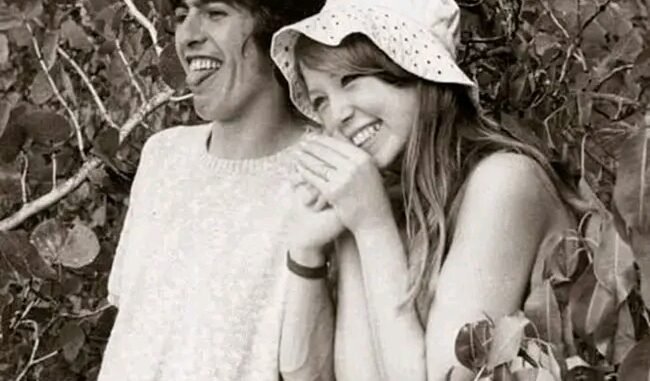
George Harrison, the revered Beatles guitarist and spiritual seeker, was renowned not only for his musical genius but also for his calm, introspective demeanor and profound spiritual pursuits. Throughout his life, he cultivated an aura of serenity, humility, and depth that endeared him to fans and friends alike. Yet beneath this tranquil exterior lay a man who experienced deep emotional pain, particularly following the dissolution of his marriage with Pattie Boyd in the mid-1970s. Their relationship had been a complex tapestry woven with love, fame, external pressures, and personal growth, and its ending marked a significant turning point in George’s life.
Pattie Boyd, a talented model and photographer, had been an integral part of George’s life since the early days of The Beatles. Their bond was built not only on romantic love but also on shared artistic pursuits and mutual spiritual exploration. However, as the 1970s progressed, their marriage faced mounting challenges. The pressures of fame, creative differences, and personal ambitions strained the relationship. The emotional toll was compounded when Pattie’s affections shifted elsewhere—specifically toward Eric Clapton, with whom she eventually fell in love. Clapton’s infatuation with Pattie became legendary, famously expressed in his heartfelt song “Layla,” which was inspired by his unrequited love for her.
When Pattie left George for Clapton, it was a profound heartbreak for him. Unlike many public figures who might respond with anger or bitterness, George chose a different path. Instead of engaging in public disputes or dwelling on resentment, he turned inward—seeking solace in meditation, music, and spiritual practice. This period of emotional upheaval became a catalyst for his deepening interest in Indian philosophy and Krishna consciousness, which would shape much of his subsequent life and work. George believed that true healing came not from external reactions but from internal reflection and spiritual growth.
Following the breakup, George retreated to Friar Park, his home and sanctuary in Oxfordshire. The sprawling estate, with its lush gardens and tranquil surroundings, became a place of refuge and renewal. Gardening became more than a hobby; it was a spiritual practice, a way to connect with nature and find peace amidst emotional turmoil. He immersed himself in the simple act of nurturing plants, finding in it a metaphor for personal growth and patience. During this time, George also spent hours playing the ukulele and exploring new musical directions, channeling his feelings into creative expression.
Simultaneously, George’s spiritual pursuits intensified. He deepened his engagement with Indian philosophy, particularly the teachings of Krishna consciousness. He became a dedicated follower of the Hare Krishna movement, finding meaning in its emphasis on love, humility, and devotion. His spiritual journey was not just a personal quest but also a way to transcend the pain of his past and find a sense of universal connection. His spiritual beliefs profoundly influenced his music, leading to compositions that reflected his inner transformation and quest for enlightenment.
In interviews, George often expressed a nuanced understanding of love and change. One of his well-known sayings encapsulates his philosophy: “You can’t cling to anything too tightly—not even love—because everything changes.” This insight reveals his acceptance of life’s impermanence and his belief that true peace comes from surrendering attachments and embracing the flow of life. His approach was rooted in humility and understanding—that suffering, growth, and healing are integral parts of the human experience.
Despite the heartbreak and emotional pain, George’s life after the breakup was marked by a renewed sense of purpose. He found joy in his music, his spiritual practice, and his natural environment. His connection with Indian music and philosophy influenced his solo work, leading to some of his most spiritually inspired compositions. Albums like *Living in the Material World* and *Thirty-Three & 1/3* reflect his ongoing journey toward inner peace and understanding.
Throughout his life, George Harrison exemplified the idea that pain can be transformed into growth. His experiences with heartbreak and loss did not diminish his gentle spirit but instead deepened his empathy, wisdom, and devotion. His story serves as a reminder that even in times of emotional upheaval, a path of meditation, music, and spiritual connection can lead to healing and renewal. George’s journey underscores the importance of inner resilience, humility, and the pursuit of higher understanding—values that continue to inspire millions around the world.
In essence, George Harrison’s life after Pattie Boyd’s departure was a testament to his unwavering belief in the transformative power of love, spirituality, and acceptance. His quiet strength and openness to change helped him navigate personal pain with grace, ultimately shaping him into a man whose legacy transcends music—becoming a beacon of spiritual awakening and inner peace.
Leave a Reply